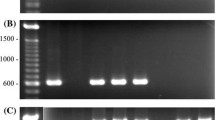Abstract
Transposon Tn917 was used to identify Bacillus thuringiensis genes required for virulence and survival in a Manduca sexta (tobacco hornworm) septicaemia model. Uniquely tagged transposons, n = 72, were constructed and used to generate 1152 insertion mutants. Sixteen pools of 72 mutants were screened in the infection model, and 12 virulence-attenuated mutants were unable to survive the infection. Analysis of the mutated DNA sequences implicated an arsR family transcriptional regulator, a histone-like DNA-binding protein, a transposon, and several sequences of unknown function in B. thuringiensis pathogenesis.

Similar content being viewed by others
Literature Cited
Agaisse H, Gominet M, Økstad OA, Kolsto AB, Lereclus D (1999) PlcR is a pleiotropic regulator of extracellular virulence factor gene expression in Bacillus thuringiensis. Mol Microbiol 32:1043–1053
Autret N, Charbit A (2005) Lessons from signature-tagged mutagenesis on the infectious mechanisms of pathogenic bacteria. FEMS Microbiol Rev 29:703–717
Baum JA, Gilmer AJ, Light Mettus AM (1999) Multiple roles for TnpI recombinase in regulation of Tn5401 transposition in Bacillus thuringiensis. J Bacteriol 181:6271–6277
Berry C, O’Neil S, Ben-Dov E, Jones AF, Murphy L, Quail MA, et al. (2002) Complete sequence and organization of pBtoxis, the toxin-coding plasmid of Bacillus thuringiensis subsp. israelensis. Appl Environ Microbiol 68:5082–5095
Coulter SN, Schwan WR, Ng EY, Langhorne MH, Ritchie HD, Westbrock-Wadman S, et al. (1998) Staphylococcus aureus genetic loci impacting growth and survival in multiple infection environments. Mol Microbiol 30:393–404
Darwin AJ, Miller VL (1999) Identification of Yersinia enterocolitica genes affecting survival in an animal host using signature-tagged transposon mutagenesis. Mol Microbiol 32:51–62
Drobniewski FA (1993) Bacillus cereus and related species. Clin Microbiol Rev 6:324–338
Edlund T, Sidén I, Boman HG (1976) Evidence for two immune inhibitors from Bacillus thuringiensis interfering with the humoral defence system of saturniid pupae. Infect Immun 114:934–941
Fedhila S, Guillemet E, Nel P, Lereclus D (2004) Characterization of two Bacillus thuringiensis genes identified by in vivo screening of virulence factors. Appl Environ Microbiol 70:4784–4791
Fernández S, Rojo F, Alonso JC (1997) The Bacillus subtilis chromatin-associated protein Hbsu is involved in DNA repair and recombination. Mol Microbiol 23:1169–1179
Guttmann DM, Ellar DJ (2000) Phenotypic and genotypic comparisons of 23 strains from the Bacillus cereus complex for a selection of known and putative Bt virulence factors. FEMS Microbiol Lett 188:7–13
Hensel M, Shea JE, Gleeson C, Jones MD, Dalton E, Holden DW (1995) Simultaneous identification of bacterial virulence genes by negative selection. Science 269:400–403
Hoffmaster AR, Koehler TM (1999) Autogenous regulation of the Bacillus anthracis pag operon. J Bacteriol 181:4485–4492
Huisman O, Faelen M, Girard D, Jaffe A, Toussaint A, Rouviere-Yaniv J (1989) Multiple defects in Escherichia coli mutants lacking HU protein. J Bacteriol 171:3704–3712
Jones AL, Knoll KM, Rubens CE (2000) Identification of Streptococcus agalactiae virulence genes in the neonatal rat sepsis model using signature-tagged mutagenesis. Mol Microbiol 37:1444–1455
Lereclus D, Agaisse H, Gominet M, Chaufaux J (1995) Overproduction of encapsulated insecticidal crystal proteins in a Bacillus thuringiensis spo0A mutant. Biotechnology (NY) 13:67–71
Mahillon J, Lereclus D (1988) Structural and functional analysis of Tn4430: Identification of an integrase-like protein involved in the co-integrate-resolution process. EMBO J 7:1515–1526
Mei J-M, Nourbakhsh F, Ford CW, Holden DW (1997) Identification of Staphylococcus aureus virulence genes in a murine model of bacteraemia using signature-tagged mutagensis. Mol Microbiol 26:399–407
Micka B, Marahiel MA (1992) The DNA-binding protein HBsu is essential for normal growth and development in Bacillus subtilis. Biochimie 74:641–650
Mignot T, Mock M, Fouet A (2003) A plasmid-encoded regulator couples the synthesis of toxins and surface structures in Bacillus anthracis. Mol Microbiol 47:917–927
Ogawa T, Wada M, Kano Y, Imamoto F, Okazaki T (1989) DNA replication in Escherichia coli mutants that lack protein HU. J Bacteriol 171:5672–5679
Pospiech A, Neumann B (1995) A versatile quick-prep of genomic DNA from gram-positive bacteria. Trends Genet 11:217–218
Rasko DA, Altherr MR, Han CS, Ravel J (2005) Genomics of the Bacillus cereus group of organisms. FEMS Microbiol Rev 29:303–329
Salamitou S, Ramisse F, Brehelin M, Bourguet D, Gilois N, Gominet M, et al. (2000) The plcR regulon is involved in the opportunistic properties of Bacillus thuringiensis and Bacillus cereus in mice and insects. Microbiology 146:2825–2832
Sambrook J, Fritsch EF, Maniatis T (1989) Molecular cloning: A laboratory manual. 2nd ed. New York, NY, Cold Spring Harbour Press
Schnepf E, Crickmore N, Van Rie J, Lereclus D, Baum J, Feitelson J, et al. (1998) Bacillus thuringiensis and its pesticidal crystal proteins. Microbiol Mol Biol Rev 62:775–806
Stewart GS, Johnstone K, Hagelberg E, Ellar DJ (1981) Commitment of bacterial spores to germinate: A measure of the trigger reaction. Biochem J 198:101–106
Stinson MW, McLaughlin R, Choi SH, Juarez ZE, Barnard J (1998) Streptococcal histone-like protein: Primary structure of hlpA and protein binding to lipoteichoic acid and epithelial cells. Infect Immun 66:259–265
Trieu-Cuot P, Courvalin P. (1983) Nucleotide sequence of the Streptococcus faecalis plasmid gene encoding the 3′5′′-aminoglycoside phosphotransferase type III. Gene 23:331–341
Turner AK, Lovell MA, Hulme SD, Zhang-Barber L, Barrow PA (1998) Identification of Salmonella typhimurium genes required for colonization of the chicken alimentary tract and for virulence in newly hatched chicks. Infect Immun 66:2099–2106
Acknowledgments
We thank Daniel Guttmann for providing protocols, David Holden for supplying pID408, Didier Lereclus for supplying pRN5101 and pDG783, and Jorge Ibarra for providing Bt MEX312. This project was funded by the BBSRC (Biotechnology and Biological Sciences Research Council).
Author information
Authors and Affiliations
Corresponding author
Rights and permissions
About this article
Cite this article
Steggles, J.R., Wang, J. & Ellar, D.J. Discovery of Bacillus thuringiensis Virulence Genes Using Signature-Tagged Mutagenesis in an Insect Model of Septicaemia. Curr Microbiol 53, 303–310 (2006). https://doi.org/10.1007/s00284-006-0037-2
Received:
Accepted:
Published:
Issue Date:
DOI: https://doi.org/10.1007/s00284-006-0037-2




